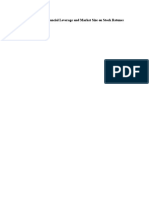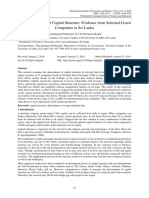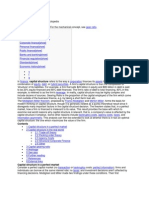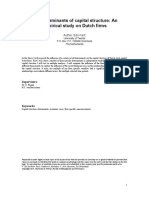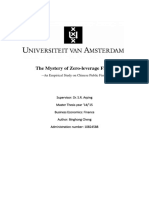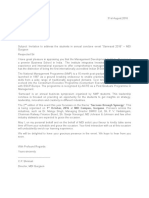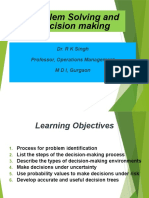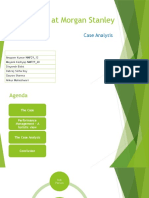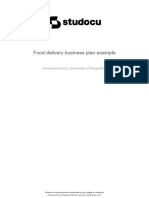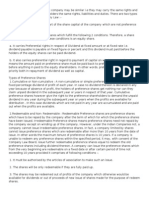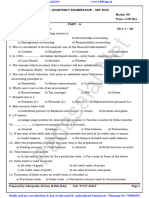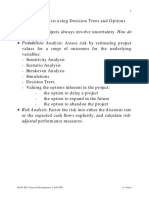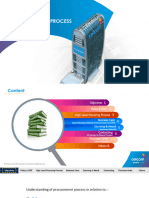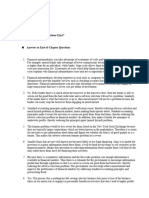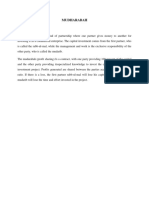Project Report for Partial Completion of
Corporate Finance Subject
Impact of size on Capital Structure: A Study of Indian Firms
Submitted to:
Professor Shaphali Gupta
Marketing
MDI, Gurgaon
Presented by:
Group-3 Section-A NMP-29
Abhijeet Sharma
Anupam Kumar
Ashish Sharma
Bhupesh Chawla
Debraj Sinha Roy
Neerja Malik
Abstract
29NMP01
29NMP13
29NMP17
29NMP21
29NMP23
29NMP47
�One of the key determinants of leverage is firm size. Larger firms are usually more
established in their markets, diversified and less likely to fail. Therefore, it has been
argued that size can be seen as an inverse measure of bankruptcy risk. The aim of
this project is to investigate the relationship between firm size and the capital
structure of Indian small and medium-sized enterprises. Most of previous studies
have shown a positive relationship between firm size and leverage. But, several
empirical studies found negative relationship between firm size and leverage.
Research indicates negative relationship between firm size and leverage. But, firm
size differently affect short-term and long-term leverage. The relationship between
firm size and short-term leverage is negative but not statistically significant in all
observed years. The relationship between firm size and long-term leverage is
positive in all observed years but is not statistically significant, except one year.
Trade-off theory predicts that larger firms tend to be more diversified, and hence
less risky and less prone to bankruptcy. Further, if maintaining control is important,
then it is likely that firms achieve larger size through debt rather than equity
financing. Thus, control considerations also support positive correlation between
size and debt. However, it can also be argued that size serves as proxy for
availability of information that outsiders have about the firm. From pecking order
point of view, less information asymmetry makes equity issuance more appealing to
the firm. Thus, a negative link between size and leverage is expected.
�Introduction
Capital structure can be define as the proportional relationship
between equity and debt. Decisions concerning capital structure
and it is way of financing is the most important issue for
managers and owners of the enterprises. However, it is not an
easy job because it involves the wise proportional selection of
debt and equity which includes different costs and benefits in
balancing between debt and equity. A wrong decision in the
selection between the funds may lead the firm to financial
distress and eventually to bankruptcy (Andrei, 2013)1 . The
process of financing takes a very important place in firm
management because it must ensure financial continuity
necessary for growth and maintaining competitiveness in their
environment. This is especially evident in transition economies,
where due to underdeveloped capital markets debt remains the
main source of financing. Capital structure theories offer a
number of determinants that are responsible for various impacts
on capital structure, while the empirical literature tend to find
evidence that firms behave in accordance with the theoretical
predictions (Shamshur, 2010)2 . Mostly they focus on those
determinants which are more likely to have a major role on
leverage decisions. Although there have been various studies
analysing capital structure, it is still debated what the
determinants of capital structure are and how they impact capital
structure decisions. Since Modigliani and Miller published their
seminal paper in 1958, the issue of capital structure has
generated great interest among researchers. From the theoretical
point of view, existing empirical studies widely used two models
of capital structure: the trade-off theory and the pecking order
theory. Trade-off theory implies that a company's capital structure
decisions involve a trade-off between the tax benefits of debt
financing and the costs of financial distress. The pecking order
theory points out that there is a certain order in financing, starting
from retained earnings as a primary source of internal financing,
then moving to debt and using equity only as the last resort. Each
�of these theories suggests how certain determinants affect capital
structure. According to theories, researchers found various
impacts of determinants on capital structure depending on the
country they are analysing.
Background
Classical Modigliani-Miller theorem (1958) asserts irrelevance of debt-to-equity ratio for firm
value. However, complete markets, no taxes, absence of transaction and bankruptcy costs, the
theory about the debt irrelevance is hardly realistic. Later, Modigliani and Miller (1963) relaxed
a no-tax assumption and developed a theory about tax benefits of debt. That paper gave rise to a
serious academic discussion on the theory of capital structure.
There are two main benefits of debt for a company. The first one is the tax shield: interest payments
usually are not taxable, hence the debt can increase the value of the firm. Another benefit is that debt
disciplines. Managers use free cash flows of the company to invest in projects, to pay dividends, or to
hold on cash balance. But if the firm is not committed to some fixed payments such as interest
expenses, managers could have incentives to waste excess free cash flows. That is why, in order to
discipline managers, shareholders attract debt. Besides, it is a popular practice in debt agreements
between banks and borrowers to introduce some financial covenants for firms (minimal level of the
free cash flow, debt-to-EBITDA ratio, EBITDA-to-interest expenses ratio etc.). Companies cannot
break these covenants, and hence are bound to be more effective. In addition, the law usually
guarantees a right of partial information disclosure to the companys debt holders, which serves
as additional managers supervision tool. As a result, actions of managers become more
transparent, and they have more incentives to create higher value for the owners. This is the
essence of Free Cash Flow Theory of capital structure.
Extravagant investments is one of the ways in which managers may not behave in the owners
best interests. This is called hazard problem. A standard example is huge exploration spending
by oil industry managers in the late 1970s, when it was cheaper to buy oil on the Wall Street than
�to drill for it or to pump it. Besides, managers of the oil industry companies invested a large part
of their excess cash into non-core activities (Jensen, 1988). Blanchard et al. (1994) showed that
managers of firms who received cash windfalls often spent them on acquisitions of unrelated
firms and other activities which did not create any value for shareholders. These and other facts
prove that conflict of interest between managers and owners exists.
The cost hypothesis predicts that higher level of debt is associated with better firm performance.
Agency costs are costs which arise in agency conflict. There are several mechanisms through
which high leverage may reduce agency costs and as a result increase firm value:
1. Monitoring activities of debt holders
2. Managers fear of firm bankruptcy and liquidation, following misuse of funds, which may
lead to losses of reputation and salaries
3. Reduction of overinvestments.
Undoubtedly, there are other ways for shareholders to discipline managers. For example, owners
may commit managers to pay dividends, leaving less free cash flow at managers disposal. As a
result, firms with clear separation of managers and owners should pay higher dividends
.However, in this study we concentrate only on debt as a disciplining mechanism.
Since the value of the firm is directly related to its performance (the better a firm performs, the
higher its value is), economists study the relationship between leverage and firm performance in
order to check theory . Empirical studies have not reached an agreement about the relationship
between leverage and firm performance yet. Coricelli et al (2011) in their EBRD study of Central and
Eastern European companies showed hump-shaped relationship between the level of debt and
productivity growth. At the same time, Majumdar and Chhibber (1999) found significantly negative
effect of level of debt on firm performance. results even in basic facts about capital structure.
Therefore, an empirical evidence of the relationship between leverage and firm performance is still
not conclusive.
�Firms with lower expected cash flows find it more costly to attract new debt. So, when the firm
attracts new debt, it commits itself to future interest payments and signals about its stable
financial position and ability to make these payments in the future.
There could also be inverse causality between firm performance and leverage. According
to efficiency-risk hypothesis, higher efficiency of the firm reduces expected costs of bankruptcy, and
such firms may attract more debt. On the other hand, according to franchise value hypothesis,
more efficient firms would like to protect economic rent derived from their efficiency, and might
choose lower leverage.
Moreover, we may expect, that relations between leverage and firm performance will not be
instantaneous and time lags could be present. Pecking order theory confirms this expectation and
explicitly states that past rather than current firm performance could have an effect on capital
structure.
In particular, we will explore the following questions: Does higher leverage results in better firm
performance? Is debt a disciplinary mechanism of the decrease of agency costs and thus in the
improvement of firm performance.
Understanding the relationship between the company debt and value could provide useful insights for
investors for two reasons. Firstly, shareholders would be able to target optimal debt-to-equity ratios,
which may improve discipline of the managers, but does not overburden a firm with extraneous
interest payments. Secondly, debt holders would have a tool in hand to identify overleveraged and
underleveraged firms. This may help them allocate their funds more effectively.
�Capital Structure Theories
1. Meaning of Capital structure:
a. It means finding the relative composition of debt-equity of the
company.
b. It is also known as financial structure of the company.
c. Since debt is used along with the equity, it is known as trading on
equity and the term trading on equity is driven from the fact that it is
the equity which is used to raise the debt.
2. Meaning of optimum capital structure:
a. Theoretically, optimum capital structure is one where EPS and market
value of share is maximum but marginal cost of each source of fund is
minimum.
b. Practically, there is no optimum capital structure. And the word
Optimum is not realistic also. Better to say appropriate capital
structure.
3. Factors determining the capital structure:
a. Basically risk, control and cost are the three factors affecting the
capital structure but there are other factors also.
b. Minimization of Risk :
i. Capital structure must be consistent with business risk.
ii. It should result in a certain level of financial risk.
c. Control: It should reflect the managements philosophy of control over
the firm.
d. Flexibility: It refers to the ability of the firm to meet the requirements of
the changing situations.
e. Profitability: It should be profitable from the equity shareholders point
of view.
f. Solvency: The use of excessive debt may threaten the solvency of the
company.
g. Cost: it refers to the overall cost capital. If it is less, the capital
structure is appropriate.
4. Capital structure theories:
a. Net income approach (NI)
b. Net operating income approach (NOI)
c. Traditional approach
d. Modigilani and Miller Approach (MM)
Net income Approach
5. Net income approach:
a. According to this approach, the weighted average cost of capital is
depended on the capital structure.
b. So by changing the debt equity ratio, firms cost and value can be
changed.
�c. Assumptions of this approach:
i. Kd < Ke
ii. No change in risk
iii. There are no corporate taxes.
d. Since net income means after tax earnings and while net operating
income means pretax earnings. But sine this method assumes no
taxes. So NI = NOI. But whenever debt is there in the question then
Net income = NOI - interest
Effect
on
K0
Increase in leverage
Decrease in leverage
Decrease (by using less expensive debt)
Increase ( since we using more
expensive equity)
Decrease (since K0 is increased)
Value of
Increase (since K0 is decreased)
firm
Leverage means using borrowed funds. In above table since you are
borrowing funds so that must be cheaper. This is assumed.
6. Steps involved in calculating the weighted average cost of capital under Net
income approach:
a. MV of equity share =
b. MV of debt =
Net income
Ke
Net operating incomeinterest
Ke
Interest
rate of interest
c. Total value of firm = MV of equity + MV of debt
d. Weighted average cost of capital K0 =
Net operating income
Total value of the firm
Net Operating income approach
7. Net operating income approach:
a. According to this approach, K0 is independent of its capital structure.
That means by changing the debt equity ratio, a firm cannot change its
value and cost of capital.
b. Assumptions of NOI approach:
i. Kd and K0 are constant.
ii. Split of market capitalization into debt and equity is insignificant
since K0 doesnt affect the value and cost of capital.
iii. There are no taxes.
iv. Neutralization :Using the less expensive debt, implicit cost
(interest) and explicit cost (increase hopes of ESH due to
increase in risk since debt is raised) are neutralized
Effect of increase in leverage
Effect on
Effect
Reason
Ke
increase High debt increases risk for ESH, so to compensate K e get
increased due to ESH hopes
K0
Constan Due to assumption of neutralization
�t
Total Value of
constan Since K0 is content
firm
t
Decrease in leverage, would have same consequences expect that K e will
decrease.
8. Steps for calculating the Ke:
a. Total value of firm =
NOI
K0
b. Total value of debt =
interest
interest rate
c. Value of equity = firms value debt value
d. Ke =
Net income
Value of equity
Net incomeinterest
Value of equity
Traditional Approach
9. Traditional approach:
a. Traditional approach is intermediate of NI and NOI approach. Since it
considers both the approaches.
b. The calculation and steps involved in this approach are same as NI
approach.
Modigilani and Millar approach
10.MM approach:
a. According to this approach, K0 is independent of its capital structure.
That means by changing the debt equity ratio, a firm cannot change its
value and cost of capital.
b. If two firms are identical in all aspects except for the degree of
leverage, firms will have different MV so the arbitrage will start.
c. Assumptions:
i. There is perfect capital market.
ii. Homogenous risk class.
iii. No taxes
iv. All investors have same expectations.
v. Company has 100% payout ratio.
d. Criticism:
i. There is no perfect market.
ii. Arbitrage may fail.
iii. Existence of corporate tax
Summary of all capital structure theories is shown in Table 1:
Table 1.
Summary of capital structure theories.
�Theory
Modigliani and Miller
(1963)
Relationship Causality
Positive
Performance affects debt
Trade-off
Positive
Performance affects debt
Pecking-Order
Negative
Performance affects debt
Free-cash-flow
Positive
Debt affects performance
Company Background:
TCS:
Type
Public
Industry
IT services, IT consulting
Founded
1968
Founder
J. T. Tata, F. C.bdjgkc
Headquarters
Mumbai, Maharashtra, India
Area served
Worldwide
Key people
N. Chandrasekaran (CEO & MD
IT, business consulting and
Services
outsourcing services
Revenue
Operating
income
US$16.54 billion (2016)[2]
Profit
US$3.70 billion (2016)
Total assets
US$13.76 billion (2016)
Total equity
Number of
employees
US$11.10 billion (2016)
Parent
CTS:
US$4.38 billion (2016)
362,079 (Aug 2016)
Tata Group
Type
Public
Industry
IT services, IT consulting
Predecessor
Dun & Bradstreet
Founded
January 26, 1994
�Founder
Kumar Mahadeva, Francisco D'Souza
Headquarters
Teaneck, New Jersey,United States
Area served
Worldwide
Key people
Francisco D'Souza (CEO)
Services
IT, business
consulting andoutsourcing services
Revenue
US$12.416 billion (2015)
Operating income
US$2.142 billion (2015)
Profit
US$1.623 billion (2015)
Total assets
US$13.065 billion (2015)
Total equity
US$9.278 billion (2015)
Number of
employees
244,300 (2016 Q2)
WIPRO:
Type
Industry
Public
Founded
IT services, IT consulting
29-12-1945,(Mumbai, Maharas
htra)
Founder
Mohamed Hasham Premji[1]
Headquarters
Bangalore, Karnataka, India
Area served
Worldwide
Key people
Azim
Premji (Chairman),Abidali
Neemuchwala (CEO)
Services
Digital Strategy, Business
Consulting and IT Services
Revenue
US$7.735 billion (2016)
Operating income
US$1.463 billion (2016)
Profit
US$1.348 billion (2016)
Total assets
US$10.94 billion (2016)
Total equity
US$7.070 billion (2016)
�Owner
Azim Premji (73%)
Number of employees
3i Infotech
173,863 (June 2016)
Type
Public company
Industry
Technology services, IT
services,Outsourcing
Founded
1993
Area served
World wide
Key people
Padmanabhan Iyer,
Executive Director & Chief
Executive Officer
Revenue
1,344.00
crore(US$200 million)
Net income
-936.52 crore (US$
140 million)
Number of employees
over 200
ROLTA:
Type
Public company
Industry
Technology services,Outsourcing
Founded
1989
Headquarters
Mumbai, India
Area served
Worldwide
Key people
Revenue
Kamal K Singh (Chairman & Managing Director)
Number of employees
~1700
36,794.57
million (US$550 million) (2015)
GEO:
Type
Public
Industry
Outsourced correctional services
Predecessor
The Wackenhut Corporation
Founded
1984 (as Wackenhut Corrections
Corporation (WCC))
Founder
George Zoley
Headquarters
621 NW 53rd St.Boca Raton, Florida, US
Area served
USA,Australia,South Africa, UK
Key people
George Zoley(Chairman) & (CEO)
Revenue
$ 1.61 billion (2011)
�Operating income
$ 192.2 million (2011)
Net income
$ 77.5 million (2011)
Total assets
$ 3.049 billion (2011)
Total equity
Number of
employees
$ 1.039 billion (2011)
20,000- 2011
Company Data for Analysis:
Company
Name
Financial
Year
Cognizant
Technology
Solutions(CTS
)
2015
2014
2013
2012
2011
2010
2009
2008
2007
2006
865367.2
725759.8
503173.0
357316.9
292498.8
204886.3
155320.0
115581.7
72456.8
58687.9
-39.47
-27.61
-61.08
-98.99
-61.53
-62.11
-52.74
-38.80
-45.66
-60.38
GEO Is.
2015
2014
2013
2012
2011
2010
2009
2008
2007
2006
7944.0
7525.0
6595.5
5662.5
4924.5
3481.3
3148.1
3447.7
4009.4
3912.8
-31.01
-22.34
-33.53
-24.40
-23.63
-7.18
-7.34
31.95
9.66
26.62
2015
2014
2013
2012
2011
2010
2009
2008
2007
13425.3
26553.0
38032.2
37749.8
40645.4
42517.2
38860.0
38576.5
23585.6
208.46
3i Infotech
Total
Assets
Net Debt To
Equity
431.34
228.90
162.80
142.58
200.17
186.24
133.89
�2006
13491.6
115.89
Rolta
2015
2014
2013
2012
2011
2010
2009
2008
2007
2006
31595.0
22556.9
9797.6
8353.2
10134.1
9372.2
9090.3
11907.4
12227.2
5470.0
209.23
227.80
208.75
131.92
70.28
71.94
57.46
13.31
-10.81
-11.43
Tata
Consultancy
Services(TCS)
2015
2014
2013
2012
2011
2010
2009
2008
2007
2006
893843.8
736608.8
671307.8
521678.7
413304.9
332607.5
273942.2
226373.4
175653.1
131861.5
-41.34
-37.41
-30.55
-18.89
-21.34
-17.45
-37.57
-23.28
-26.85
-22.86
WIPRO
2015
2014
2013
2012
2011
2010
2009
2008
2007
2006
724921.0
600033.0
502304.0
439730.0
436001.0
371443.0
329928.0
278511.0
216340.0
141550.0
-22.80
-32.70
-35.71
-31.52
-21.20
-23.97
-1.20
-6.08
4.73
-50.24
�Results:
A. Correlation Results of Capital Structure & Assets for Wipro:
Correlations
Wipro Total Assets
Wipro Total
Wipro Net Debt
Assets
To Equity
Pearson Correlation
-.189
Sig. (2-tailed)
.601
N
Wipro Net Debt To Equity
Pearson Correlation
10
10
-.189
Sig. (2-tailed)
.601
10
10
Result: Weak Negative Correlation.
B. Correlation Results of Capital Structure & Assets for TCS:
Correlations
TCS Total Assets
TCS Total
TCS Net Debt
Assets
To Equity
Pearson Correlation
Sig. (2-tailed)
N
TCS Net Debt To Equity
Pearson Correlation
Sig. (2-tailed)
N
Result: Medium Negative Correlation.
-.569
.086
10
10
-.569
.086
10
10
�C. Correlation Results of Capital Structure & Assets for CTS:
Correlations
CTS Total Assets
CTS Total
CTS Net Debt
Assets
To Equity
Pearson Correlation
Sig. (2-tailed)
.454
N
CTS Net Debt To Equity
.268
10
10
Pearson Correlation
.268
Sig. (2-tailed)
.454
10
10
Result: Weak Positive Correlation.
D. Correlation Results of Capital Structure & Assets for GEO:
Correlations
GEO Total Assets
Pearson Correlation
GEO Total
GEO Net Debt
Assets
To Equity
1
Sig. (2-tailed)
N
GEO Net Debt To Equity
Pearson Correlation
Sig. (2-tailed)
N
-.728*
.017
10
10
-.728
.017
10
10
*. Correlation is significant at the 0.05 level (2-tailed).
Result: Medium Negative Correlation
E. Correlation Results of Capital Structure & Assets for 3i Infotech:
�Correlations
3i Net Debt To
Equity
3i Net Debt To Equity
3i Total Assets
Pearson Correlation
.283
Sig. (2-tailed)
.460
N
3i Total Assets
Pearson Correlation
.283
Sig. (2-tailed)
.460
10
Result: Weak Positive Correlation.
F. Correlation Results of Capital Structure & Assets for Rolta:
Correlations
Rolta Total Assets
Pearson Correlation
Rolta Total
Rolta Net Debt
Assets
To Equity
1
Sig. (2-tailed)
N
Rolta Net Debt To Equity
.628
.052
10
10
Pearson Correlation
.628
Sig. (2-tailed)
.052
Result: Medium Positive Correlation.
10
10









